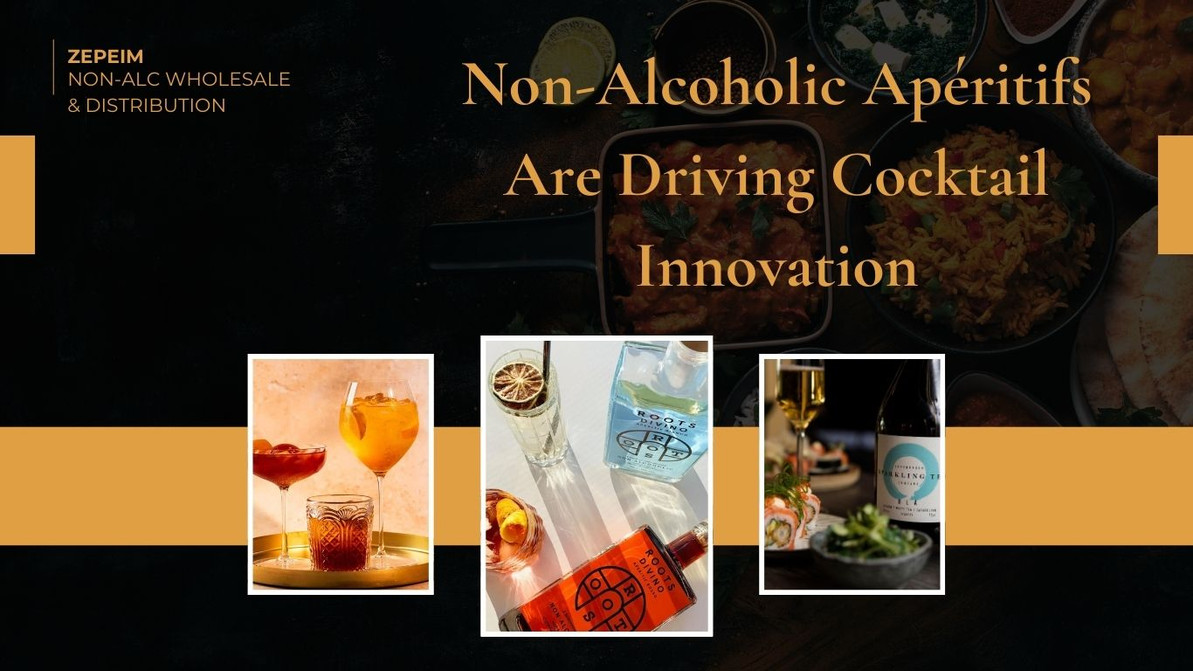Non-Alcoholic Apéritifs Are Driving Cocktail Innovation
From spritz programs to low-ABV style service without alcohol, non-alcoholic apéritifs are where the most exciting zero-proof cocktail R&D is happening. This article breaks down how to build profitable, culinary-grade apéritif drinks—covering flavor architecture, batching, service rituals, and go-to products from the Zepeim portfolio.
Why apéritifs lead zero-proof innovation
- Bittersweet structure = depth: Classic apéritif markers—citrus peel, gentian, wormwood, roots, and spice—provide the bite, lift, and finish many guests miss in sweet “mocktails.”
- Food-first versatility: Dry, aromatic profiles fit pre-dinner service, amuse-bouches, raw/veg courses, and chef’s tasting menus.
- Operational wins: Shelf-stable components, clean batching, and consistent specs reduce waste and speed service during peak covers.
Hero products to anchor your builds

Roots Divino Bianco (0.0% ABV)
Wine-based, herb-driven (rosemary, thyme, wormwood) “bianco” apéritif with savory lift and a crisp, dry finish—excellent for bitter-balanced spritzes and vermouth-style highballs.
Use cases: White Negroni riffs (zero-proof), bianco spritz, citrus-saline highball for raw bar.

Lyre’s Italian Orange (<0.5% ABV)
Bitter orange apéritif profile with blood orange, red citrus, and pithy dryness. Builds backbone in spritzes and Americano/Negroni-style recipes.
Use cases: Italian Orange & Tonic; zero-proof Negroni (Italian Orange + Roots Bianco + NA “gin”).

Melati Classic (0.0% ABV)
Aromatic, culinary-grade build (goji, chokeberry, cacao, damiana, florals, spice). Dry, layered, and cocktail-ready—think apéritif with Southeast Asian nuance.
Use cases: Spice-framed spritz; Melati Collins (Melati + citrus + soda) with lemongrass garnish.

Lyre’s Classico RTD (<0.5% ABV)
Pre-dinner sparkling built for speed rails, banquets, and poolside service—clean green-apple and stone-fruit notes in a dry can format.
Use cases: Welcome pour alternative; NA “spritz service” without back-bar complexity.
Technical build principles (that bartenders actually use)
- Balance like a classic: Target a dry profile with bittersweet center. If using a sweeter apéritif, add a saline drop (3–5 g/L brine) or a splash of tonic to sharpen finish.
- Dilution & bubbles: For spritz specs, start at
1:1(apéritif : sparkling component) over ice; adjust to1:0.75if using highly aromatic bases. Top with soda to lengthen without sweetness. - Acid structure: NA apéritifs shine with citric/malic support. Fresh citrus, verjus, or acid-adjusted juice restores snap lost without ethanol.
- Bitterness management: Layer gentian/wormwood-style bitterness (Roots Divino) with orange-peel bitterness (Lyre’s Italian Orange) to create depth without harshness.
- Aromatics last: Express oils (grapefruit, lemon) over the top; add herbs (thyme, rosemary) after stirring to prevent muddled profiles.
Menu architecture & pricing best practices
- Lead with ritual: Frame a “Pre-Dinner Apéritifs” section before signatures. Use stemware and tableside pours for perceived value.
- Anchor SKUs: One red-bitter, one bianco, one aromatic (e.g., Italian Orange, Divino Bianco, Melati), plus a ready-to-serve spritz can for volume service.
- Price the experience: Position apéritif cocktails with your craft cocktail tier (not as “soft drinks”).
- Batching SOP: Pre-dilute still apéritif builds for draft or speed pour (e.g., 750 mL apéritif + 150–200 mL water), then finish with CO₂ or top with soda to order.
- Pairings on the menu: Add a one-line pairing under each drink (crudo, citrus-led salad, chèvre tartine).
Three proven specs to start tomorrow
- Bianco Spritz (dry)
2 oz Roots Divino Bianco + 2 oz dry sparkling (or soda) over ice in a wine glass. Lemon peel, thyme sprig. - Red-Bitter Highball
1.5 oz Lyre’s Italian Orange + 4–5 oz tonic over ice. Orange wheel, pinch of sea salt. - Aromatic Collins
1.5 oz Melati Classic + 0.5 oz lemon + top with soda in a Collins. Lemongrass swizzle.
Staff language that sells (fast)
- “Looking for a proper pre-dinner drink?” “Our bianco spritz is crisp, herbal, and bone-dry—great with oysters or crudités.”
- “Want the Negroni vibe without alcohol?” “We layer Italian Orange with a bianco apéritif for that bittersweet snap and long finish.”
- “Not into sweet mocktails?” “These are chef-level apéritifs—bittersweet, aromatic, and food-friendly.”
Ready to build your apéritif program?
Zepeim supplies the category’s leading non-alcoholic apéritifs, sparkling alternatives, and mixers with hospitality-grade support.
Apply for a wholesale account to access pricing, training, and nationwide distribution.
Frequently Asked Questions
What makes non-alcoholic apéritifs different from mocktails?
Unlike sweet mocktails, apéritifs are crafted with bitterness, botanicals, and acidity for depth and food-pairing structure. They replicate the pre-dinner ritual of classic aperitivo service.
Do apéritifs contain any alcohol?
Most Zepeim portfolio apéritifs are 0.0% ABV, though some products like Lyre’s Italian Orange are labeled <0.5% ABV. Always check labeling and follow house service policies.
How do you serve a non-alcoholic apéritif?
Serve chilled, often lengthened with soda, tonic, or sparkling tea. Use proper glassware and garnishes (citrus, herbs) to elevate presentation and mirror full-strength cocktail service.
Can apéritifs be pre-batched for service?
Yes—shelf-stable apéritifs like Melati Classic or Roots Divino Bianco can be pre-diluted and stored cold for high-volume service. Finish with soda or garnish at the pass.
Which cocktails are easiest to adapt to non-alcoholic apéritifs?
Spritzes, Negronis, and Americanos adapt seamlessly. For example, a zero-proof Negroni can be built with Lyre’s Italian Orange, Roots Divino Bianco, and a non-alc “gin” base.
Why should restaurants feature non-alcoholic apéritifs?
They increase inclusivity, provide upsell opportunities, and position the program as modern and wellness-forward. Guests expect to see premium non-alc options treated with equal care as cocktails and wine.
Recent Posts
-
The 2026 Luxury Non-Alcoholic Beverage Report: How Premium Zero-Proof Sparkling Is Transforming Fine Dining, Guest Experience & Hospitality Revenue
The luxury beverage world is undergoing its most significant shift in decades. Guests at three-Mich …Nov 12th 2025 -
Planning for Q4: Get Ahead on Your Holiday Beverage Strategy
Holiday success is planned—not improvised. With lead times tightening and demand peaking from Thank …Oct 8th 2025 -
Non-Alcoholic Apéritifs Are Driving Cocktail Innovation
From spritz programs to low-ABV style service without alcohol, non-alcoholic apéritifs are where th …Sep 1st 2025




